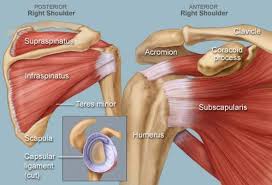Shoulder Pain
Intervertebral Disk (IVD)
The Shoulder Complex: a disclaimer
The shoulder complex is made up of the glenohumeral, scapulothoracic, sternoclavicular and acromioclavicular joints with 18 associated muscles and a multitude of ligaments. The following article tries to break down some of the more common problems that affect with the shoulder complex. However, appreciate that problems can overlap and often there are simultaneous disorders that can affect the shoulder.

The glenohumeral (ball and socket) joint is the most mobile joint in our body but as a trade-off is an unstable joint to allow for this motion. The rotator cuff is a dynamic stabiliser mechanism created by the four muscles depicted in the graphic.
The rotator cuff muscles maintain congruency of the joint surfaces allowing for smooth and seamless motion.
Unfortunately, problems can occur with the rotator cuff, especially the supraspinatus which can get externally impinged beneath the bony prominence (acromion) of the shoulder blade. This is known as subacromial impingement (SAI) and is often associated with tendinopathy, calcification, muscle tears and even complete tendon rupture1.
Typical Symptoms may include:
- Pain/clicking on shoulder movement
- Painless weakness/ weakness
- ‘Catching’ sensation/pain
- Worse with overhead movement/ work
- Reduced shoulder mobility
- Reduced confidence in movement
Treatment plan: Every patient is unique and the approach will reflect this.
Together, you and your osteopath will discuss a course of action and treatment which best suits you.
Common key areas to be addressed may include:
- Shoulder muscles function appropriately for smooth and efficient motion
- Mobility of shoulder complex and its related joints
- Cervical spine, thoracic spine and rib mobility
- Exercises for mobility, strengthening and pain management
- Effects of ergonomics (desk, sleeping, driving), posture and work-related activity on pain and shoulder function
- Other risk factors of SAI explored and addressed
1.Shoulder Doc. Subacromial Impingement. Available at: https://www.shoulderdoc.co.uk/section/9 [Accessed 20/06/2017]
Labral Tears
The labrum is the fibrocartilaginous structure that deepens the socket of the glenohumeral (ball and socket) joint. This provides extra support to the shoulder to help compensate for its instability. Tears of the labrum can occur with trauma and/or repetitive over arm use e.g. throwing, with the location of the tear dependent on the mechanism of injury:
- SLAP – top area of the labrum, can be associated with bicep tendon tear/tendinopathy
- Bankart – front of the labrum, associated with anterior dislocations and common in rugby players
- Kim – back/bottom of the labrum, associated with posterior dislocations (less common)
Typical Symptoms may include:
- Shoulder pain with overhead/cross the body movement
- Pain that radiates down the arm
- Weakness/ stiffness
- Feeling of instability
- Popping, clicking and/or catching sensation
Treatment plan: Every patient is unique and the approach will reflect this. Together, you and your osteopath will discuss a course of action and treatment which best suits you. Common key areas to be addressed may include:
- Local musculature – identification and treatment of myofascial trigger points (MFTP) of the head, neck and shoulders
- Cervical spine, thoracic spine and rib mobility
- Manage return to activity
- Progressive rehabilitation program
- Exercises for mobility, strengthening and pain management
- Effects of ergonomics (desk, sleeping, driving), posture and work-related activity on pain and shoulder function
- Refer for further investigations if necessary
Frozen Shoulder (Adhesive Capsulitis)
Frozen shoulder or Adhesive Capsulitis has been described as a ‘condition of uncertain aetiology characterised by significant restriction of both active and passive shoulder motion that occurs in the absence of a known intrinsic shoulder disorder1. This basically translates into: a stiff/painful shoulder for no apparent reason.
The main structure in the shoulder that is affected is the glenohumeral (ball and socket) capsule or the connective tissue around the joint. We do not fully understand why this happens but is more common with
- Diabetes
- Thyroid conditions (hypothyroidism)
- Ischaemic Heart Disease
- Shoulder Trauma/ Surgery
- Period of immobilisation/ inactivity
The clinical progression of Frozen Shoulder tends to go through three phases2:
- Freezing or Painful stage = lasts 2-9 months; increasingly painful shoulder
- Frozen or Stiffening stage = lasts 4-20 months; reduced pain with restricted shoulder
- Thawing or Resolution stage = lasts 5-26 months; improving movement and pain
These timings will vary depending on the resource you quote but from onset to resolution, Frozen Shoulder can last anywhere between 1 and 5 years.
Typical symptoms depend on the stage of the disorder but may include:
- Insidious onset with dull pain around the shoulder
- Disturbed sleep due to pain
- Significant loss shoulder mobility
- Sharp pain with movement
- May follow minor trauma
Treatment plan: Frozen Shoulder natural progression varies in time taken however it will resolve and the long-term outcomes are fundamentally the same. **UPDATE: Recent systemic reviews of the evidence suggest that Frozen Shoulder does not improve of its own accord without treatment3 and encourages early intervention and treatment for optimum recovery**
Together, you and your osteopath will discuss a course of action and treatment which best suits you. Common key areas to be addressed may include:
- Exercise regime to help restore motion and reduce pain
- Reduce muscle tension around the shoulder
- Treat Myofascial Trigger Points (MFTPs)
- Improve movement patterns of other areas: scapulothoracic, thoracic spine, etc
- Joint mobilisation/ traction therapy
- Education on Frozen Shoulder and natural progression
- Expectation
- Anti-inflammatory medication
- Address risk factors (diabetes, hypothyroidism, ischaemic heart disease)
- Referral for corticosteroid injections
- Surgery reserved for patients who do not respond to conservative treatment
1.Zuckerman & Rokito. 2011. Frozen shoulder: a consensus definition. J Shoulder Elbow Surg. 20(2): 322-5
2.Medscape 2017. Adhesive Capsulitis (Frozen Shoulder). Available at: http://emedicine.medscape.com/article/1261598-overview [Accessed on 21/06/2017]
3.Wong, C.K. et al. 2017. Natural history of frozen shoulder: fact or fiction? A systematic review. 103(1):40-47


